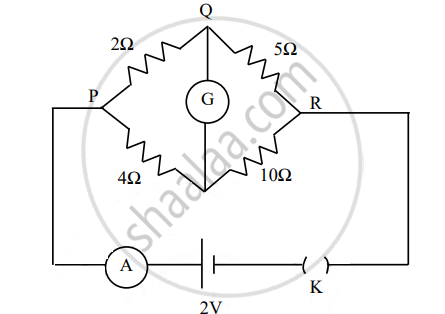Advertisements
Advertisements
प्रश्न
Draw a labelled diagram of a moving coil galvanometer. Describe briefly its principle and working.
उत्तर
Principle:
Its working is based on the fact that when a current carrying coil is placed in a magnetic field, it experiences a torque.

Working:
Suppose the coil PQRS is suspended freely in the magnetic field.
Let l = length PQ or RS of the coil
b = breadth QR or SP of the coil
n = number of turns in the coil
Area of each turn of the coil, A = l × b
Let B = strength of the magnetic field in which the coil is suspended
I = current passing through the coil in the direction PQRS
At any instant, let α be the angle that the normal drawn on the plane of the coil makes with the direction of magnetic field.
The rectangular coil carrying current, when placed in the magnetic field, experiences a torque whose magnitude is given by:
τ = nIBA sinα
Due to the deflecting torque, the coil rotates and the suspension wire gets twisted. A restoring torque is set up in the suspension wire.
Let θ be the twist produced in the phosphor bronze strip due to the rotation of the coil and K be the restoring torque per unit twist of the phosphor bronze strip. Then, we have:
Total restoring torque produced = kθ
In equilibrium position of the coil, we have:
Deflecting torque = Restoring torque
∴ NIBA = kθ
or
`I=k/(NBA)theta " or "Gtheta`
Here,
`K/(NBA)=G=a["constant for a galvanometer"]`
It is known as galvanometer constant.
APPEARS IN
संबंधित प्रश्न
The combined resistance of a galvanometer of resistance 500Ω and its shunt is 21Ω. Calculate the value of shunt.
A coil of radius 10 cm and resistance 40 Ω has 1000 turns. It is placed with its plane vertical and its axis parallel to the magnetic meridian. The coil is connected to a galvanometer and is rotated about the vertical diameter through an angle of 180°. Find the charge which flows through the galvanometer if the horizontal component of the earth's magnetic field is BH = 3.0 × 10−5 T.
Why are the pole pieces of a horseshoe magnet in a moving coil galvanometer made cylinder in shape?
A galvanometer coil has a resistance of 12 Ω and the metre shows full scale deflection for a current of 3 mA. How will you convert the metre into a voltmeter of range 0 to 18 V?
The conversion of a moving coil galvanometer into a voltmeter is done by ______.
A voltmeter of variable ranges 3 V, 15 V, 150 V is to be designed by connecting resistances R1, R2, R3 in series with a galvanometer of resistance G = 20 Ω, as shown in Fig. The galvanometer gives full pass through its coil for 1 mA current i.e. "gives full pass through it's coil for 1 mA current". Then, the resistances R1, R2 and R3 (in kilo ohms) should be, respectively:

When a galvanometer is shunted with a 4 Ω resistance, the deflection is reduced to one-fifth. If the galvanometer is further shunted with a 2 Ω wire. The further reduction (find the ratio of decrease in current to the previous current) in the deflection will be (the main current remains the same)
The figure below shows a circuit containing an ammeter A, a galvanometer G and a plug key K. When the key is closed:

A galvanometer of resistance 100 Ω gives a full-scale deflection for a potential difference of 200 mV.
- What must be the resistance connected to convert the galvanometer into an ammeter of the range 0-200 mA?
- Determine resistance of the ammeter.
